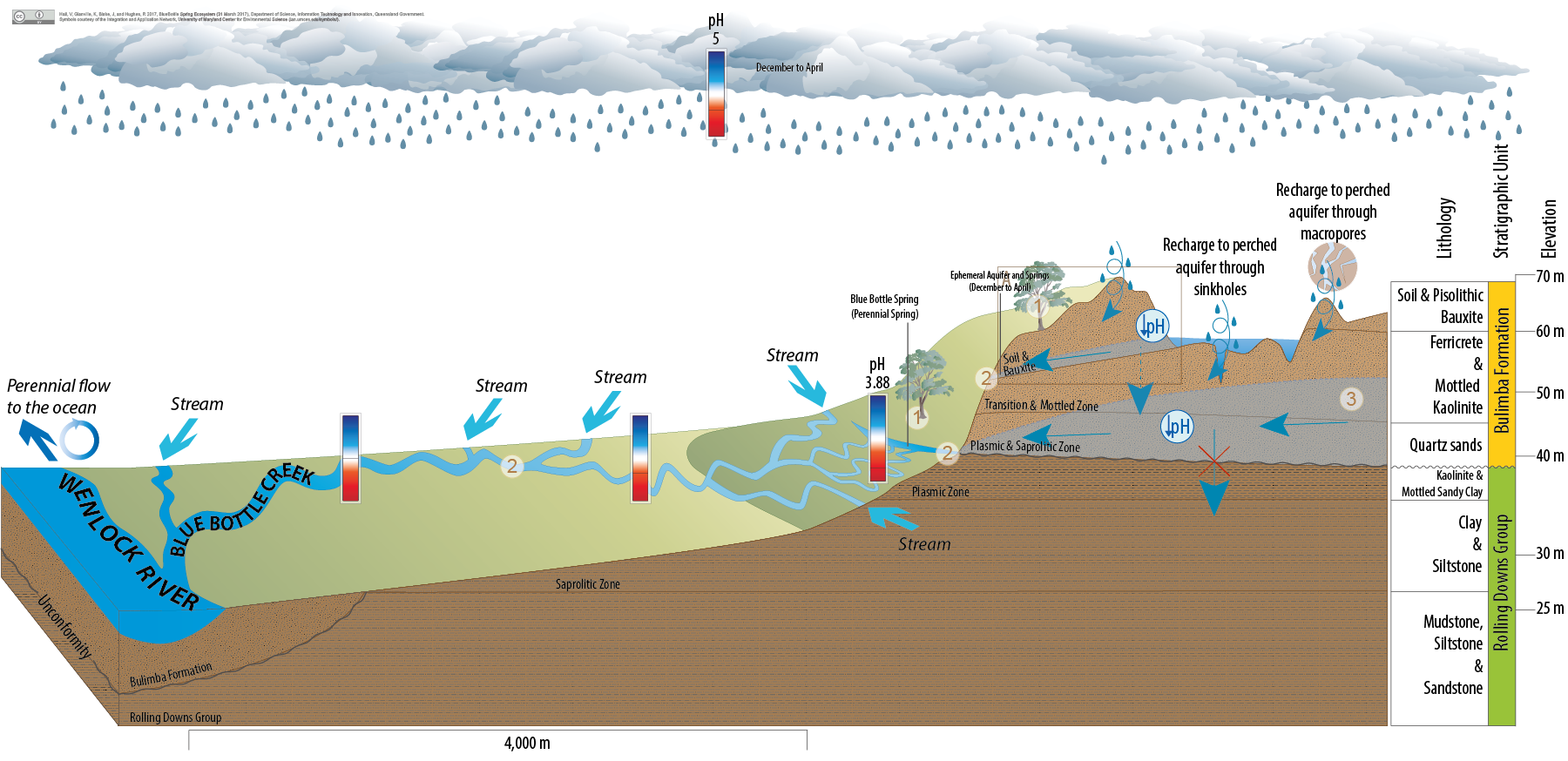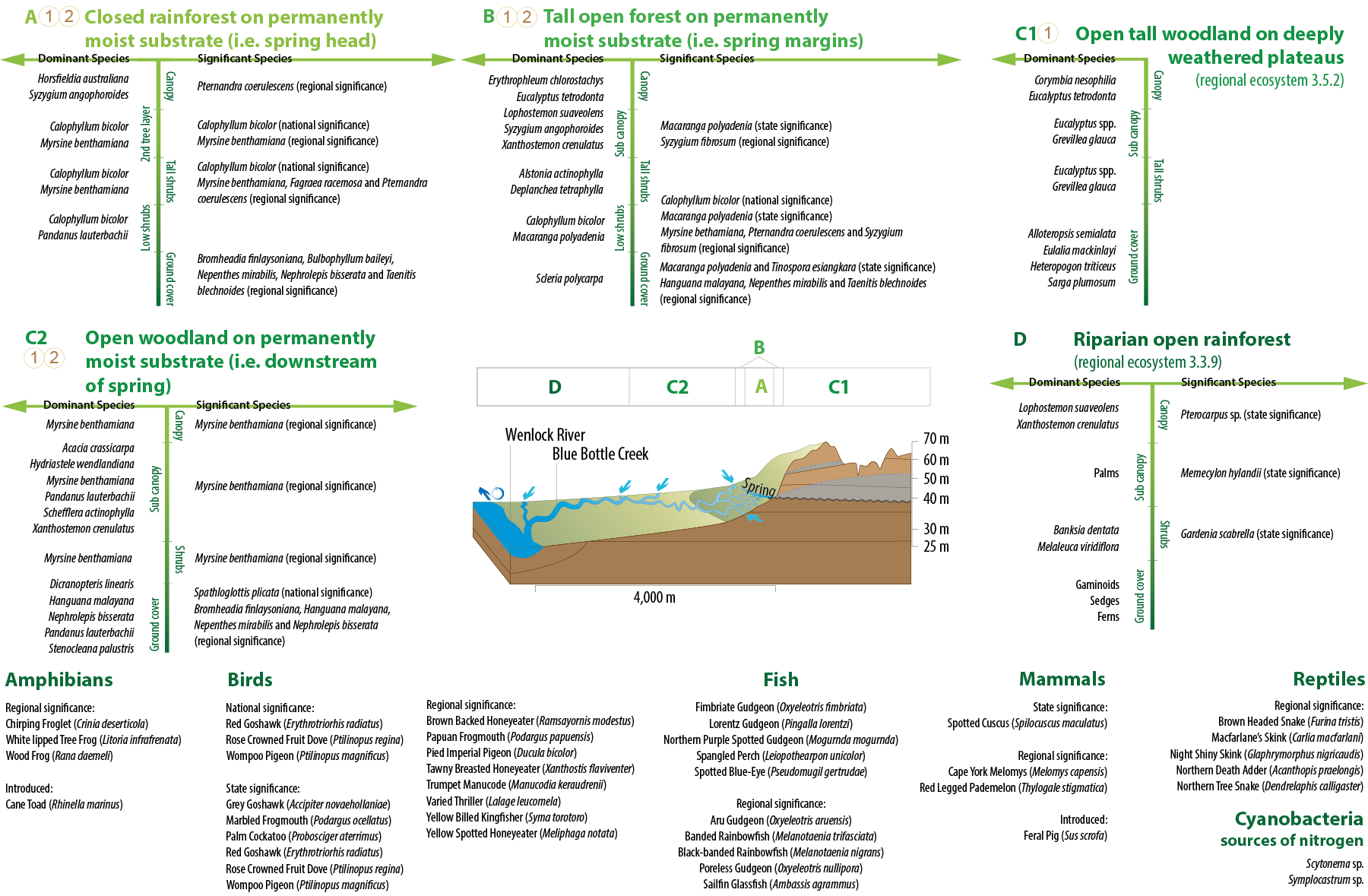|
|
BlueBottle SpringBlueBottle SpringClick on elements of the model or select from the tabs below BlueBottle Spring, Cape YorkBlueBottle Spring is a permanent bauxite spring in Weipa Plateau supported by an aquifer overlying, but separate to, the Great Artesian Basin. Weipa Plateau is a remnant of the extensive, deeply weathered western coastal plains of Cape York Peninsula[8]. This plateau is an estimated 50 km wide with slight elevation of up to 15 m near the coast, rising to 70 m in the east[8]. The gently rolling hills of the plateau are dissected by discontinuous drainage and deep incisions that have been carved out by major rivers such as the Archer and Wenlock Rivers[6][2][8]. Based on information collected during a drilling program conducted by Winders (2010)[9], the following sequence of geological layers near BlueBottle Spring is consistent with the broader geological profile of the Weipa Plateau[1][3][7].
Groundwater discharge can occur where a permeable geological layer (e.g. Bulimba Formation) overlies a less permeable layer (e.g. Rolling Downs Group). At this site plasmic zone (b) is composed of well-compacted clay that acts to slow or prevent vertical groundwater flow. Given sufficient rainfall and recharge, this can result in groundwater accumulating above the clay and flowing laterally until it is discharged to the surface (e.g. BlueBottle Spring). In addition, groundwater may accumulate on less permeable kaolinite in other geological layers (e.g. mottled zone) and flow laterally until it is discharged to the surface or able to continue vertical movement. BlueBottle Spring occurs in a continuous 650- metre arc at approximately 50 metre elevation near the contact between the Bulimba Formation and underlying the less permeable plasmic zone of the Rolling Downs Group. Groundwater emanating from BlueBottle Spring gradually coalesces into a number of small streams which join to form one stream (Blue Bottle Creek) approximately 400 metres down-gradient of the discharge location. Four kilometres downstream of BlueBottle Spring groundwater discharged from the spring enters the Wenlock River providing significant freshwater flow to the river during the dry season. Flow from Blue Bottle Spring to the Wenlock River remains strong well into the late dry season, except for the last kilometre where infiltration is likely to occur. While groundwater discharge from BlueBottle Spring remains strong each year, there is a slow, steady reduction in flow observed to occur each dry season indicating a local aquifer recharge source. Lyon and Franklin (2009)[5] have indicated that the water draining from the springs is acidic with an observed pH of 3.8 at the point of discharge and noted that the pH of the groundwater decreases with increasing distance from the spring. A number of factors have been identified that may contribute to spring acidity including rainfall acidity, chemical weathering, plant activity, decay of vegetation, termite activity, bacteria activity and fungi activity. Recent research supports the contribution of anerobic microbial degradation to groundwater chemistry[4]. In addition, isotopic values at the spring suggest groundwater has meteoric origins, representing a mix of rainfall events[4]. Pictorial conceptual model PDF References
Last updated: 10 April 2017 This page should be cited as: Queensland Government, Queensland (2017) BlueBottle Spring, WetlandInfo website, accessed 25 June 2024. Available at: https://wetlandinfo.des.qld.gov.au/wetlands/ecology/aquatic-ecosystems-natural/groundwater-dependent/bluebottle-spring/ |

 — Department of Environment, Science and Innovation
— Department of Environment, Science and Innovation




